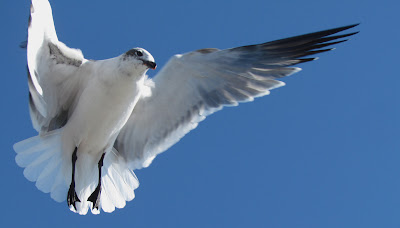Man, time really got away from me. I totally meant to post this when James and I got back from our Christmas Bird Counts out east, but somehow it got lost among everything else that was going on. Anyway, enjoy this write-up of the day we visited the legendary Lake Mattamuskeet.
When you hear about Lake Mattamuskeet, you immediately think of some Eden-like paradise for waterfowl in eastern North Carolina. When I visited in the winter of 2010, one could house almost a half-million waterfowl in their scope view at one time. The Christmas Bird Count this year was very different, and with the mild winter many ducks stayed up north. Not that it mattered, really – James, Scott and I ended up counting an area that lacked most of the birds associated with that large expanse of water.
That’s not to say we didn’t find some good birds, just not the ones we were expecting. Rather than getting loads of waterbirds, we ended up having rather a different birding experience than we were used to. There were thousands of blackbirds in a small containment pond, hundreds of Killdeer in an open field, and birds that wouldn’t shy away as per usual. For example, I almost never see Black-crowned Night Herons unless I flush them, and even then they’re drab, immature birds. That day, however, we found several adults roosting peacefully along a canal, apparently enjoying the mid-day sun.
 |
| Dunno why they call 'em Night Herons - I've never seen one at night! |
And there were Kestrels everywhere. Every powerline we crossed had an American Kestrel on it, bobbing its tail, surveying the fields. Once, we found a Northern Harrier mobbing a Red-tailed Hawk, vocalizing as it swooped low. Once the hawk was gone, however, a miniscule American Kestrel began to berate the much larger harrier, truly looking like nature’s version of David and Goliath. Of course, the Kestrel just couldn’t keep to itself, and ended up scaring off a nearby Belted Kingfisher. Luckily, once the falcon was out of sight, the kingfisher didn’t mind a couple birders in a large car inching closer – a far cry from the ones we get inland!
 |
| I find coastal kingfishers a huge improvement over their inland brethren. |
All along the canals of rural Hyde County, we found birds. Sometimes we saw Pied-billed Grebes, dipping and diving in whatever small amount of water they could find. Great Blue Herons were common too, and somewhat more surprisingly, many Great Egrets dotted the recently-plowed fields, often quite close to the road. As we watched one of the egrets, James noticed a small brown bird nestled among the packed clods of loose earth – it was a Wilson’s Snipe, pretty much the closest I’ve ever gotten to one. In the afternoon sun, I was able to truly appreciate the intricate patterning that let it become invisible to all but the sharpest-eyed birders.
 |
| Luckily, James has eyes like a hawk. Or eagle. I dunno, something with good eyes. Elf? |
After cruising our area for most of the day, James and I made our way to the fabled Lake Mattamuskeet causeway to check out what waterfowl we could find. However, on a fifty-degree day in late December, all that we could muster were thousands of Tundra Swans, with several American Black Ducks mixed in. As I stayed on the lower end of the causeway, trying to pish through the enumerable Orange-crowned Warblers trying to find a much better Nashville, James strode ahead and managed to find this pair of Tundra Swans near the shore. While he was watching, one of the swans let out a tremendous muscular flap of its wings – an event that one doesn’t easily forget!
 |
| It's amazing - before I came out east, I never realized how common these things really were! |
Back at the lower causeway, Forster’s Terns flew overhead, vocalizing as they skimmed the waters searching for prey. None of the birds would get very close, save for a lone Bonaparte’s Gull that seemed to find itself at home on a small concrete drainage pipe that graded into the lake. Even as James ventured within three feet of the bird, it stood its ground, preferring its perch to fleeing from a photographer. James ended up with walk-away views of this bird, which as any veteran can tell you, is almost as good as getting said bird as a lifer.
 |
| As one young birder was keen to tell me last month, it's named after the much-less successful nephew of Napoleon. |
The day wore down and we watched the sunset from across the Pamlico Sound. Cormorants and scoters flew past the fiery orb trying to extinguish itself for the night, and while James got his lifer White-winged Scoter, it wouldn’t nearly amount to the amazing views we had of North Carolina’s more common avian denizens. Sure we’d seen them all before, but not like we saw them that day. Awesome doesn’t even begin to describe it.







































